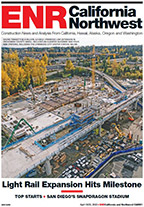ENR California & Northwest: 2019 Top Starts

The Automated People Mover system under construction at LAX will run on a 2.25- mile elevated guideway.
RENDERING COURTESY OF LOS ANGELES WORLD AIRPORTS
Before the coronavirus pandemic struck, construction in California, the Pacific Northwest and Hawaii was solid, with billions of dollars of new projects breaking ground last year. The 2019 California Top Starts list, which includes 55 projects, is led by airline, hotel and mixed-use, water sanitation and solar work. The Northwest Top Starts list includes 21 projects.
The top spots on the California/Hawaii list belong to projects at Los Angeles International Airport (LAX) that are part of its $5.5-billion Landside Access Modernization Program (LAMP). Leading the way is the $2.7-billion Automated People Mover (APM) for Los Angeles World Airports (LAWA).
The APM is an electric train that runs on a 2.25-mile elevated guideway, with six stations that will connect airport terminals to the newly built consolidated rental car facility, intermodal transportation facilities, expanded airport parking and Metro transit. Fluor Corp. is leading the design-build joint venture team known as LINXS Constructors, which includes Balfour Beatty, Flatiron and Dragados.
|
Related Link |
Currently, crews are relocating critical utilities as well as building the foundations and structures for the APM and building the system’s future Maintenance and Storage Facility. Passenger service is scheduled for 2023.
“Starting with design, the innovative approach to the APM project integrates a focus on sustainability through construction strategies that minimize energy consumption and adverse environmental effects, promote indoor environmental quality and reduce resource consumption,” says Sharon Gookin, LINXS Constructors project director. “The APM system is striving for an Envision Platinum rating, while the APM’s Maintenance and Storage Facility is working for a LEED Gold classification.”
Another $1.7-billion project is the San Francisco Public Utilities Commission Biosolids Digester Facilities, one of the largest biosolids projects in the country. The project replaces all the solids processing facilities at SFPUC’s largest wastewater treatment plant. It is designed for an average of 85 million gallons per day and will treat 80% of the city’s wastewater.
The design team is being led by Brown and Caldwell and includes CH2M (now Jacobs), Black & Veatch, STRUCTUS, SRT consultants, MWA Architects and more than a dozen local firms. The CM/GC project is led by the MWH Constructors/Webcor Builders Joint Venture. Substantial completion is scheduled for 2026, with final completion in 2027.
Costs increased on the project in 2019 due to changing market conditions, says Tracy Stigers, Brown and Caldwell’s project manager. “Now with COVID-19, it will need to adapt again. SFPUC’s commitment to meeting the project objectives remains intact, and the team is looking forward to advancing the project while the world and the industry recover from COVID-19,” Stigers says.
Jim Householder, project executive for Sundt, says COVID-19 is also affecting the $350-million Rancho Los Amigos South Campus ISD and Probation Headquarters project in Downey, Calif., for which Sundt is the contractor and SmithGroup is the designer. “Contract negotiations are confidently proceeding with candid communication and leadership exhibited by both the county of Los Angeles and Sundt-SmithGroup teams,” says Householder.
The design-build project, set to complete in fall 2022, will construct a 472,000-sq-ft probation department headquarters on 12.7 acres.
Also in the top five on ENR’s California list is The Grand in downtown Los Angeles, a $950-million mixed-used development located near Walt Disney Concert Hall. Designed by Frank Gehry, the Grand is being developed by Related Cos. in partnership with CORE USA. Related is working with AECOM/Tishman to build and manage the project.
Topping the list of 2019 starts in the Northwest is ConocoPhillips Alaska Inc.’s $1-billion Greater Mooses Tooth 2 Oil and Gas Development near Anchorage. The project, which continues the production of oil and gas from federal lands in the 22.1-million-acre National Petroleum Reserve-Alaska, creates a 14-acre pad and up to 48 wells, plus an 8.6-mile pipeline connecting GMT’s Phase 2 with Phase 1.
The $850-plus-million remodel and additions to Seattle’s KeyArena will nearly double the footprint of the 57-year-old arena and move the 400-car parking garage and loading docks underground, while protecting and upgrading the arena’s iconic roof.





